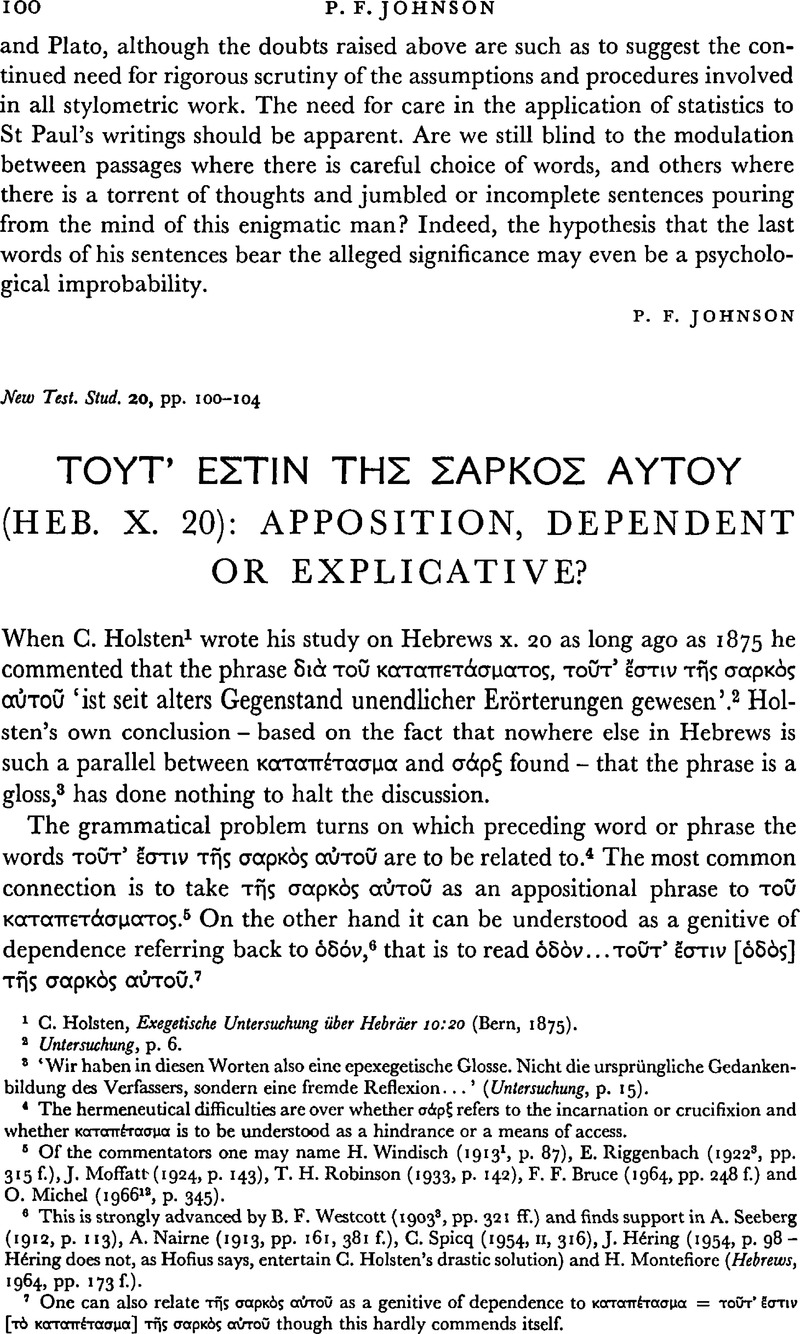Published online by Cambridge University Press: 05 February 2009

page 100 note 1 Holsten, C., Exegetische Untersuchung über Hebräer 10:20 (Bern, 1875).Google Scholar
page 100 note 2 Untersuchung, p. 6.
page 100 note 3 ‘Wir haben in diesen Worten also eine epexegetische Glosse. Nicht die ursprüngliche Gedankenbildung des Verfassers, sondern eine fremde Reflexion…’ (Untersuchung, p. 15).
page 100 note 4 The hermeneutical difficulties are over whether σάρδ refers to the incarnation or crucifixion and whether καταπέταρμα is to be understood as a hindrance or a means of access.
page 100 note 5 Of the commentators one may name H. Windisch (19131, p. 87), E. Riggenbach (19223, pp. 315 f.), J. Moffatt (1924, p. 143), T. H. Robinson (1933, p. 142), F. F. Bruce (1964, pp. 248 f.) and O. Michel (196612, p. 345).
page 100 note 6 This is strongly advanced by B. F. Westcott (19033, pp. 321 ff.) and finds support in A. Seeberg (1912, p. 113), A. Nairne (1913, pp. 161, 381 f.), C. Spicq (1954, II, 316), J. Héring (1954, p. 98–Héring does not, as Hofius says, entertain C. Holsten's drastic solution) and H. Montefiore (Hebrews, 1964, pp. 173 f.).
page 100 note 7 One can also relate τῆς σαρκός αύτοῦ as a genitive of dependence to καταπέτασμα = λοῦτ έοτιν [τό καταπέτασμα] τῆς σαρκός αύ though this hardly commends itself.
page 101 note 1 E.g. Rom. ix. 8, x. 7.
page 101 note 2 Hofius, O., ‘Inkarnation und Opfertod Jesu nach Hebr 10, 19 f.’, in Der Ruf Jesu und die Antwort der Gemeinde, Festschr. Jeremias, J. ed. Lohse, E. (Göttingen, 1970), pp. 132–41.Google Scholar
page 101 note 3 Cf. Bruce, F. F., Hebrews, p. 247.Google Scholar
page 101 note 4 Andriessen, P., ‘Das größere und vollkommenere Zelt (Hebr 9: 11)’, B.Z. XV (1971), 76–92Google Scholar, and ‘Quelques passages difficiles de l'Épître aux Hébreux’, Biblica, LI (1971), 207–20.Google Scholar
page 101 note 5 τούτ έστιν occurs eighteen times in the New Testament, six times in Hebrews, even times in Paul and five times elsewhere, a fact against Holsten's view that Heb. x. 20b is a gloss.
page 101 note 6 Andriessens's claim of support from Heb. ix. 2 and vii. II is not compelling; nor the claim that the absence of the article from όδός makes it the worthy object of the espexegetic phrase of x. 20b.
page 101 note 7 To say that word-order is not decisive does not mean that it is irrelevant. In the case of Heb. vii. 5 and xiii. 15 the substantives qualified by the τού τ έοτιν phrase are the only ones that could be so qualified; whereas with Heb. x. 20 one must bypass the first possibility (καταπέταρμα) if one wishes to relate τῆς σαρκξός αύτού dependently to όδόν.
page 102 note 1 Cf. C. Spicq, II, 316. Hofius offers only Justin, Dial. 118. 3: διά τ⋯ς κλήσεως τ⋯ς καιν⋯ς καì αίωνίου διαθήκης, τοũτ' ἕστιν τοũ χριστοũ, which is probably a genitive of dependence related to διαθήκης.
page 102 note 2 ‘Faßt man die Worte τοũτ' ἔστιν τ⋯ς σαρκōς αύτοũ nicht von vornherein als Apposition zu διά τοũ καταпετάσματος auf, so ist durch nichts gefordert, für διά in beiden Fällen die gleiche Bedeutung anzunehmen’ (Inkarnation, p. 136).
page 102 note 3 Inkarnation, p. 136.
page 102 note 4 J. Jeremias, ‘Hebräer 10:20 τοũτ' ἔστιν τῆς σαρκός αύτοũ’, Z.N.W. LXII (1971), 131.Google Scholar
page 102 note 5 Z.N.W. LXII (1971), 131.Google Scholar
page 103 note 1 Hebrews, p. 173.
page 103 note 2 The suggestion that σαρκός is related to άγíων made by Glombitza, O. (‘Erwägungen zum Kunstvollen Ansatz der Paraenese im Brief an die Hebräer – x 19–25’ in Nov Test IX (1967), 135)Google Scholar can be dismissed.
page 103 note 3 Όρέγω of course takes the genitive.
page 103 note 4 In contrast to the example from Justin previously mentioned.
page 104 note 1 Cf. H. Montefiore, op. cit. p. 173. Sabourin, L., ‘Sacrificium ut liturgia in Epistula ad Hebraeos’, V.D. XLVI (1968), 247.Google Scholar
page 104 note 2 Gardiner, F., ‘On Heb. x. 20’, J. Soc. Bib. Lit. Exeg. (1888), p. 142.Google Scholar
page 104 note 3 Ibid. p. 146. This is contra O. Hofius, Inkarnation, p. 136; J. Jeremias, Z.N.W. (1971), p. 131; and Michaelis, W., T.D.N.T. V, 77.Google Scholar
page 104 note 4 Moffatt, J., Hebrews, p. 143.Google Scholar
page 104 note 5 Dahl, N. A., ‘A New and Living Way—The Approach to God According to Hebrews 10: 19–25’, Interpretation, V (1951), 403.Google Scholar
page 104 note 6 Taking όδòν…ℑὂσαν as meaning ‘der immer gangbar ist (=όδōς μένουσα)’, rather than ‘der zum Leben führt (=όδōς ℑῶῆς)’, see O. Michel, Hebräerbrief, p. 345.
page 104 note 7 Luck, U., ‘Himmlisches und Irdisches im Hebräerbrief’, Nov.Test. v (1963), 209Google Scholar: ‘Das Leiden und Sterben Jesu ist der Vorhang’.